William Maynard Gomm facts for kids
Quick facts for kids
Sir William Maynard Gomm
|
|
|---|---|

Portrait by William Salter (oil on canvas, 1834-1840)
|
|
| Born | 10 November 1784 Barbados, West Indies |
| Died | 15 March 1875 (aged 90) Brighton, Sussex |
| Allegiance | |
| Service/ |
British Army |
| Years of service | 1799–1856 |
| Rank | Field Marshal |
| Commands held | Northern District Commander-in-Chief, India |
| Battles/wars | French Revolutionary Wars Napoleonic Wars |
| Awards | Knight Grand Cross of the Order of the Bath |
| Other work | Constable of the Tower |
Field Marshal Sir William Maynard Gomm (born November 10, 1784 – died March 15, 1875) was an important officer in the British Army. He had a very long and active career, fighting in many major wars of his time. He is especially known for his part in the Napoleonic Wars, including the famous Battle of Waterloo.
After his fighting days, he held important leadership roles. He was the Commander of troops in Jamaica and later the Governor of Mauritius. His final big job was Commander-in-Chief, India, where he made important changes to how army officers were promoted.
Contents
Early Life and Military Start
William Maynard Gomm was born in Barbados in 1784. His father was a soldier, Lieutenant-Colonel William Gomm, who died fighting in 1794. Because of his father's bravery, young William was given a special start in the army.
He became an ensign (a junior officer) in the 9th Regiment of Foot in May 1794, when he was only nine years old. He was promoted to lieutenant in 1795, but he continued his schooling.
Fighting in Europe
Gomm officially joined his regiment in 1799. He was sent to the Netherlands and fought in battles there in 1799. He also took part in an expedition to Ferrol, Spain, in 1800.
In 1803, he became a captain and studied at the Royal Military College. He then served in the Battle of Copenhagen in 1807.
The Peninsular War
Gomm joined Sir Arthur Wellesley's army during the Peninsular War in Spain and Portugal. He was an assistant quartermaster-general, which meant he helped with planning and supplies. He fought in the Battle of Roliça and the Battle of Vimeiro in 1808.
After a short break, Gomm returned to Portugal in 1810. He took part in many more important battles, including the Battle of Bussaco (1810) and the Battle of Fuentes de Oñoro (1811). He was promoted to major in 1811.
He continued to fight bravely, including at the Siege of Ciudad Rodrigo and the Siege of Badajoz in 1812, where he was injured. He also fought in the Battle of Salamanca (1812) and was promoted to lieutenant colonel.
Gomm then took part in the Siege of Burgos (1812), the Battle of Vitoria (1813), and the Siege of San Sebastián (1813). He was wounded again during the Battle of the Nive in 1813.
The Battle of Waterloo
After returning to England, Gomm joined the famous Coldstream Guards. In 1815, during the period known as the Hundred Days, he served as a staff officer with the 5th Division.
He fought in both the Battle of Quatre Bras and the very important Battle of Waterloo in June 1815. At Waterloo, he rode a horse named "George," which lived for many more years until 1841. For his service, he received the Russian Order of St. Anna.
Later Commands and Achievements
Gomm continued to rise through the ranks, becoming a colonel in 1829 and a major-general in 1837.
Commander in Jamaica
In 1839, he became the Commander of the British troops in Jamaica. He noticed that many British soldiers were dying from yellow fever. However, he saw that fewer soldiers got sick in the cooler mountain areas. Because of this, he decided to build new army barracks high up in the mountains at Newcastle, Jamaica. This helped to keep the soldiers healthier.
Governor of Mauritius and Commander-in-Chief, India
After a brief time leading the Northern District in the UK, Gomm was appointed Governor of Mauritius in 1842. He was promoted to lieutenant-general in 1846.
In 1849, he was chosen to become the Commander-in-Chief, India, the top military leader in British India. He finally took up this important role in December 1851. While in India, Gomm made a significant change: he introduced special exams for officers to get promoted. This meant that officers had to prove their knowledge and skills to move up in rank.
Retirement and Final Years
Gomm was promoted to full general in 1854 and retired from active service in 1856. He continued to receive honors, becoming a Knight Grand Cross of the Order of the Bath in 1859 and a field marshal in 1868.
In 1872, he became the Constable of the Tower, a very old and respected position at the Tower of London. Sir William Maynard Gomm died in Brighton in 1875 at the age of 90.
Family Life
Sir William Maynard Gomm was married twice. In 1817, he married Sophia Penn, who was a great-granddaughter of William Penn, the founder of Pennsylvania. After she passed away in 1827, he married Elizabeth Kerr in 1830. He did not have any children from either marriage.
Lady Elizabeth Gomm died in 1877. In her will, she left money to create the "Sir William and Lady Gomm Charity." This charity was set up to help elderly people in Rotherhithe, a part of London. A building called Lady Gomm House still exists today, named after her.
Images for kids
See also
 In Spanish: William Maynard Gomm para niños
In Spanish: William Maynard Gomm para niños



